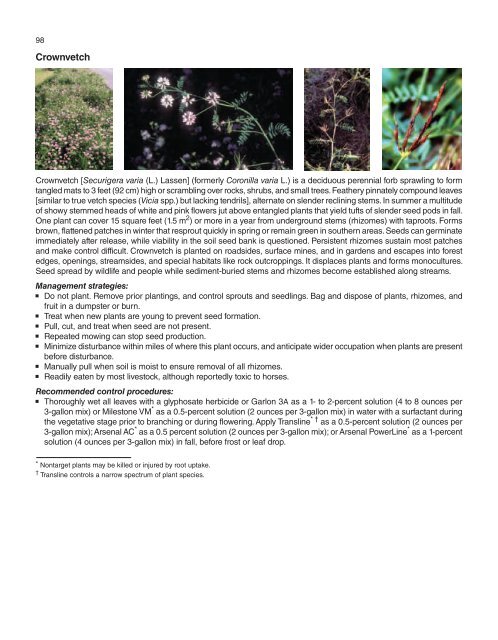A Management Guide for Invasive Plants in Southern Forests James ...
A Management Guide for Invasive Plants in Southern Forests James ...
A Management Guide for Invasive Plants in Southern Forests James ...
- No tags were found...
Create successful ePaper yourself
Turn your PDF publications into a flip-book with our unique Google optimized e-Paper software.
98CrownvetchCrownvetch [Securigera varia (L.) Lassen] (<strong>for</strong>merly Coronilla varia L.) is a deciduous perennial <strong>for</strong>b sprawl<strong>in</strong>g to <strong>for</strong>mtangled mats to 3 feet (92 cm) high or scrambl<strong>in</strong>g over rocks, shrubs, and small trees. Feathery p<strong>in</strong>nately compound leaves[similar to true vetch species (Vicia spp.) but lack<strong>in</strong>g tendrils], alternate on slender recl<strong>in</strong><strong>in</strong>g stems. In summer a multitudeof showy stemmed heads of white and p<strong>in</strong>k flowers jut above entangled plants that yield tufts of slender seed pods <strong>in</strong> fall.One plant can cover 15 square feet (1.5 m 2 ) or more <strong>in</strong> a year from underground stems (rhizomes) with taproots. Formsbrown, flattened patches <strong>in</strong> w<strong>in</strong>ter that resprout quickly <strong>in</strong> spr<strong>in</strong>g or rema<strong>in</strong> green <strong>in</strong> southern areas. Seeds can germ<strong>in</strong>ateimmediately after release, while viability <strong>in</strong> the soil seed bank is questioned. Persistent rhizomes susta<strong>in</strong> most patchesand make control difficult. Crownvetch is planted on roadsides, surface m<strong>in</strong>es, and <strong>in</strong> gardens and escapes <strong>in</strong>to <strong>for</strong>estedges, open<strong>in</strong>gs, streamsides, and special habitats like rock outcropp<strong>in</strong>gs. It displaces plants and <strong>for</strong>ms monocultures.Seed spread by wildlife and people while sediment-buried stems and rhizomes become established along streams.<strong>Management</strong> strategies:Do not plant. Remove prior plant<strong>in</strong>gs, and control sprouts and seedl<strong>in</strong>gs. Bag and dispose of plants, rhizomes, andfruit <strong>in</strong> a dumpster or burn.Treat when new plants are young to prevent seed <strong>for</strong>mation.Pull, cut, and treat when seed are not present.Repeated mow<strong>in</strong>g can stop seed production.M<strong>in</strong>imize disturbance with<strong>in</strong> miles of where this plant occurs, and anticipate wider occupation when plants are presentbe<strong>for</strong>e disturbance.Manually pull when soil is moist to ensure removal of all rhizomes.Readily eaten by most livestock, although reportedly toxic to horses.Recommended control procedures:Thoroughly wet all leaves with a glyphosate herbicide or Garlon 3A as a 1- to 2-percent solution (4 to 8 ounces per3-gallon mix) or Milestone VM * as a 0.5-percent solution (2 ounces per 3-gallon mix) <strong>in</strong> water with a surfactant dur<strong>in</strong>gthe vegetative stage prior to branch<strong>in</strong>g or dur<strong>in</strong>g flower<strong>in</strong>g. Apply Transl<strong>in</strong>e * † as a 0.5-percent solution (2 ounces per3-gallon mix); Arsenal AC * as a 0.5 percent solution (2 ounces per 3-gallon mix); or Arsenal PowerL<strong>in</strong>e * as a 1-percentsolution (4 ounces per 3-gallon mix) <strong>in</strong> fall, be<strong>for</strong>e frost or leaf drop.* Nontarget plants may be killed or <strong>in</strong>jured by root uptake.† Transl<strong>in</strong>e controls a narrow spectrum of plant species.
















